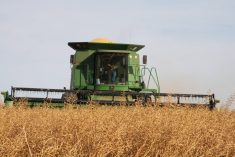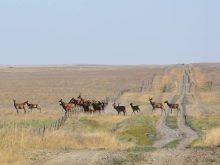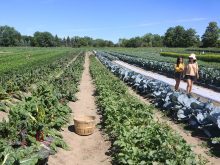Beyond yeast, it is hops that give beer its unique flavour.
That’s where Northernhawk Hops Garden comes in.
Rab Jordan, co-owner of Northernhawk Hops, near Beaumont, Alta., worked hops gardens in the United Kingdom in his youth. When he came to Canada, he teamed up with Franc Parker to establish their hops growing operation.
“(We) were looking for a crop to grow, looked at hops and spent a couple of years experimenting with various cultivars before deciding to put in the first acre in 2017,” said Jordan.
Read Also

Canada told trade crisis solutions in its hands
Canadians and Canadian exporters need to accept that the old rules of trade are over, and open access to the U.S. market may also be over, says the chief financial correspondent for CTV News.
Jordan and his team grow several varieties of hops including Bitter Gold, Centennial, Cascade, Chinook, Fuggle, Glacier, Nugget, Triple Perle and Willamette.
“We have more Centennial and Willamette than the other varieties,” Jordan said.
The operation focuses on hops that are hardy in Zone 3 growing conditions, but other challenges exist as well.
“Setting up the infrastructure is an expensive and labour-intensive undertaking.”
He said stringing the hops, training the bines to go up the strings, the large amounts of nitrogen required and weeds are all obstacles.
Northernhawk doesn’t use chemical amendments or pesticides, so weeding has been a central task over the years. This season, Jordan and his team hope to experiment with mulch to see if it can reduce weeds.
Northernhawk has also had to overcome strong winds.
“We also required a windbreak against the prevailing winds and set up a three-row break as the winds can damage the growing bines and, at times, break the supporting strings,” Jordan said.
Hops are heavy feeders, so frequent soil amendments and testing are needed.
He said labour shortages also present a big hurdle.
“One of the main challenges is to be able to find sufficient labour to work in the hops gardens. We occasionally have students on work experience.
“Another challenge is early frosts around harvest time. We set up smudge barrels at night to keep the frost off the ground. It is semi-successful.”
Once established, hops can be in production for up to 25 years.
But setting up a hops operation can be slow off the start because it takes three years for hops to reach full maturity.
When harvest comes, the crop needs special consideration.
“The bines are cut down and placed into a specialized harvester, which separates the cones… some must be plucked by hand.
“The same day, the cones are then dried at a low temperature to about 12 percent moisture then either packaged into vacuum-sealed bags and stored in a freezer, or pelletized… and stored at room temperature,” Jordan said.
“After drying, a sample of cones is lab-tested for acids and oils. Hops cones must be dried on day of picking to avoid mould.”
Selling their hops into the local Alberta market has been difficult at times with cheaper imports from the United States and other provinces providing stiff competition.
“Some breweries are tied into contracts with (American) hops agents, and are waiting for their contracts to end to start buying local hops,” Jordan said.
Yet, demand for local hops remains high from home brewers, and there is growing demand from horse owners for hops to prevent and treat laminitis, Jordan said.
Other emerging markets for hops include sleep aids, sources of estrogen for hormone therapy, veterinary applications, decor in dried plant arrangements, culinary uses of the early shoots or the cones for seasoning, and as scents for candles or oils.
Jordan said he and his team see a future in which hops provide a large part of their income, but for the time being they expect to have some off-farm work to supplement.
Northernhawk Hops plans to expand to 10 acres from three in the next few years and Jordan said the company hopes to carry out its own processing and packaging soon as well.

















